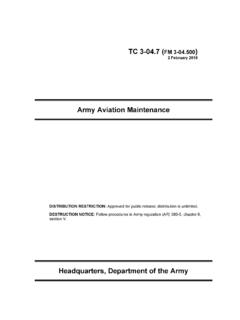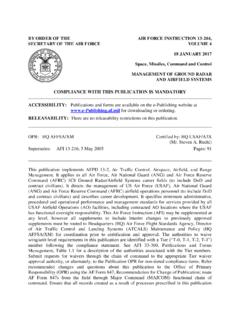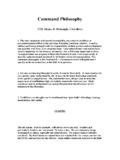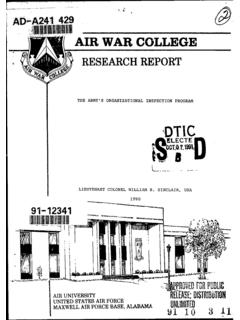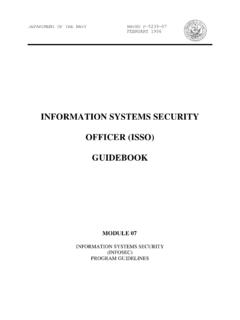Transcription of AIR FORCE INSTITUTE OF TECHNOLOGY
1 FIXED-WING AIRCRAFT COMBAT SURVIVABILITY ANALYSIS FOR OPERATION ENDURING FREEDOM AND OPERATION IRAQI FREEDOM THESIS Christopher L. Jerome, Captain, USAF AFIT/GAE/ENY/11-M14 DEPARTMENT OF THE AIR FORCE AIR UNIVERSITY AIR FORCE INSTITUTE OF TECHNOLOGY Wright-Patterson Air FORCE Base, Ohio APPROVED FOR PUBLIC RELEASE; DISTRIBUTION UNLIMITEDi AFIT/GAE/ENY/11-M14 The views expressed in this thesis are those of the author and do not reflect the official policy or position of the United States Air FORCE , Department of Defense, or the Government. This material is declared a work of the Government and is not subject to copyright protection in the United States.
2 Ii AFIT/GAE/ENY/11-M14 FIXED-WING AIRCRAFT COMBAT SURVIVABILITY ANALYSIS FOR OPERATION ENDURING FREEDOM AND OPERATION IRAQI FREEDOM THESIS Presented to the Faculty Department of Aeronautics and Astronautics Graduate School of Engineering and Management Air FORCE INSTITUTE of TECHNOLOGY Air University Air Education and Training Command In Partial Fulfillment of the Requirements for the Degree of Master of Science in Aeronautical Engineering Christopher L. Jerome, Captain, USAF March 2011 APPROVED FOR PUBLIC RELEASE; DISTRIBUTION UNLIMITED iv AFIT/GAE/ENY/11-M14 Abstract The primary tenet of the aircraft survivability discipline is threat definition. In order to deliver relevant capabilities and protection to the warfighter it is imperative; therefore, to provide timely, accurate, and actionable threat data to the survivability community.
3 Application of this threat data is equally important to both new acquisition programs and long-term sustainment programs. In an attempt to identify the evolution of aircraft threats in today s combat environment, an analysis of fixed-wing aircraft battle damage was conducted. This analysis reports aircraft battle damage incidents from OPERATIONS ENDURING FREEDOM (OEF) and IRAQI FREEDOM (OIF). Additionally, reported battle damage incidents were then validated by cross-referencing aircraft maintenance records from this period to eliminate non-hostile fire data points. Thus, only combat hostile action incidents are considered. This revolutionary approach uncovered discontinuities, which were further explored to identify their root cause.
4 As a result, significant Air FORCE policy changes in the realm of battle damage reporting procedures were suggested. The recommended changes, contained herein, are intended to increase the accuracy of the data presented to decision makers and the efficacy of survivability programs. In the end, lives will be saved because the acquisition community at large will have valuable threat data in which they can be confident. v Acknowledgements First, I would like to acknowledge the INSTITUTE for Defense Analysis. The mentorship and assistance by certain members made this thesis possible. Thank you to all of my AFIT professors especially my thesis advisor. Without your patience and guidance, I would not have been successful.
5 I would also like to thank my fellow yeomen whose camaraderie sustained me throughout my tenure at AFIT. This experience would not have been as fun without you. Above all, I would like to express my sincere gratitude to my wife for her unwavering support and my son for inspiring me to be the best that I can be. Together, you give me purpose. vi TABLE OF CONTENTS Page Disclaimer i Title Page ii Approval Page iii Abstract iv Acknowledgments v Table of Contents vi List of Figures viii List of Abbreviations xi I.
6 Introduction 1 Background and History 2 Research Objectives 12 II. Literature Review 16 The Aircraft Combat Survivability Discipline 17 Aircraft Battle Damage Repair (ABDR) Evolution 21 Director, Operational Test and Evaluation (DOT&E) 26 Joint Aircraft Survivability Program (JASP) 28 III. Methodology 33 Information Databases 33 Scope Refinement 38 IV. Results and Analysis 41 Aircraft-centric Battle Damage Cluster 42 Threat-centric Battle Damage Cluster 45 vii Page Interim Data Summary 49 Data Verification 53 Discrepancy Analysis 54 Maintenance Records and Requirements 55 Field-level Repair Options 59 Tactical Airlift Case Study 68 V.
7 Conclusions/Recommendations 82 General Technical Order Change Recommendations to Improve the Battle Damage Reporting Process 91 Weapon System Specific ABDR Manual Revision Recommendations 96 Mid-term Battle Damage Documentation Recommendations 97 Long-term Battle Damage Documentation Recommendation 98 Conclusion 99 Bibliography 101 viii List of Figures Figure Page 1-1 Early 1900 s Era Monoplane 2 1-2 B-17 Bomber Flying Fortress Bomber Crash 4 1-3 B-17 Flying Fortress Formation 5 1-4 McDonnell Douglas (Boeing) F-4 Phantom II 7 1-5 F-4 Empennage Battle Damage 9 1-6 Risk Assessment Matrix 14 2-1 Aircraft Survivability Balance 16 2-2 One vs.
8 One Kill Chain (Single Shot) 19 2-3 Hypothetical Kill Chain Illustrating an Insurgent vs. Aircraft 20 2-4 Keys to the AEF Vision 24 2-5 JASP Organization Chart 29 2-6 Battle Damage Information Flow 32 3-1 REMIS Database and Customers 37 3-2 Aircraft Battle Damage Subdivisions 39 4-1 Aircraft Combat Loss and Damage Incidents 42 ix Figure Page 4-2 Aircraft Combat Damage Only Incidents 43 4-3 Casualties Associated with Combat Incidents 44 4-4 Loss and Damage Incidents by Threat Category 46 4-5 Damage Only Incidents by Threat Category 48 4-6 Casualties by Threat Category 49 4-7 Aircraft Combat Damage Incidents (Corrected)
9 50 4-8 Damage Only Incidents, by Threat Category 51 4-9 Tactical Airlift Combat Damage Incidents, by Threat Category 52 4-10 Notional Maintenance Group Organization 56 4-11 Notional Damage Resolution Flow 60 4-12 C-130J Vertical Stabilizer and Rudder Battle Damage 61 4-13 Technical Assistance Request (TAR) Flowchart 63 4-14 Example Technical Assistance Request Identifying Aircraft Battle Damage 66 4-15 Example Technical Assistance Request with Reporting Instructions 67 4-16 C-23 Sherpa 69 4-17 C-130 Hercules 71 x Figure Page 4-18 Phases of Hydrodynamic Ram 74 4-19 Phase of Fire Growth and Effects 75 4-20 C-130 ESF 77 4-21 C-27J Spartan (JCA) 80 xi List of Abbreviations AAA Anti-aircraft Artillery ABDR Aircraft Battle Damage Repair AIAA American INSTITUTE of Aeronautics and Astronautics ASDAT Aircraft Shoot Down Assessment Team (USA)
10 CDIRS Combat Damage Incident Reporting System DoD Department of Defense DOT&E Director, Operational Test & Evaluation FAA Federal Aviation Administration FMC Fully Mission Capable GWOT Global War on Terrorism IADS Integrated Air Defense Systems IR Infrared ISA Islamic State of Afghanistan JASPO Joint Aircraft Survivability Program Office JCAT Joint Combat Assessment Team JTCG/AS Joint Technical Coordinating Group for Aircraft Survivability LFT&E Life Fire Test & Evaluation M&S Modeling and Simulation MANPADS Man Portable Air Defense Systems MDS Mission Design Series NMC Non-Mission Capable xii OEF OPERATION ENDURING FREEDOM OIF OPERATION IRAQI FREEDOM OSD Office of the Secretary of Defense PMSG Principal Members Steering Group RAF Royal Air FORCE RDT&E Research ,Development.










